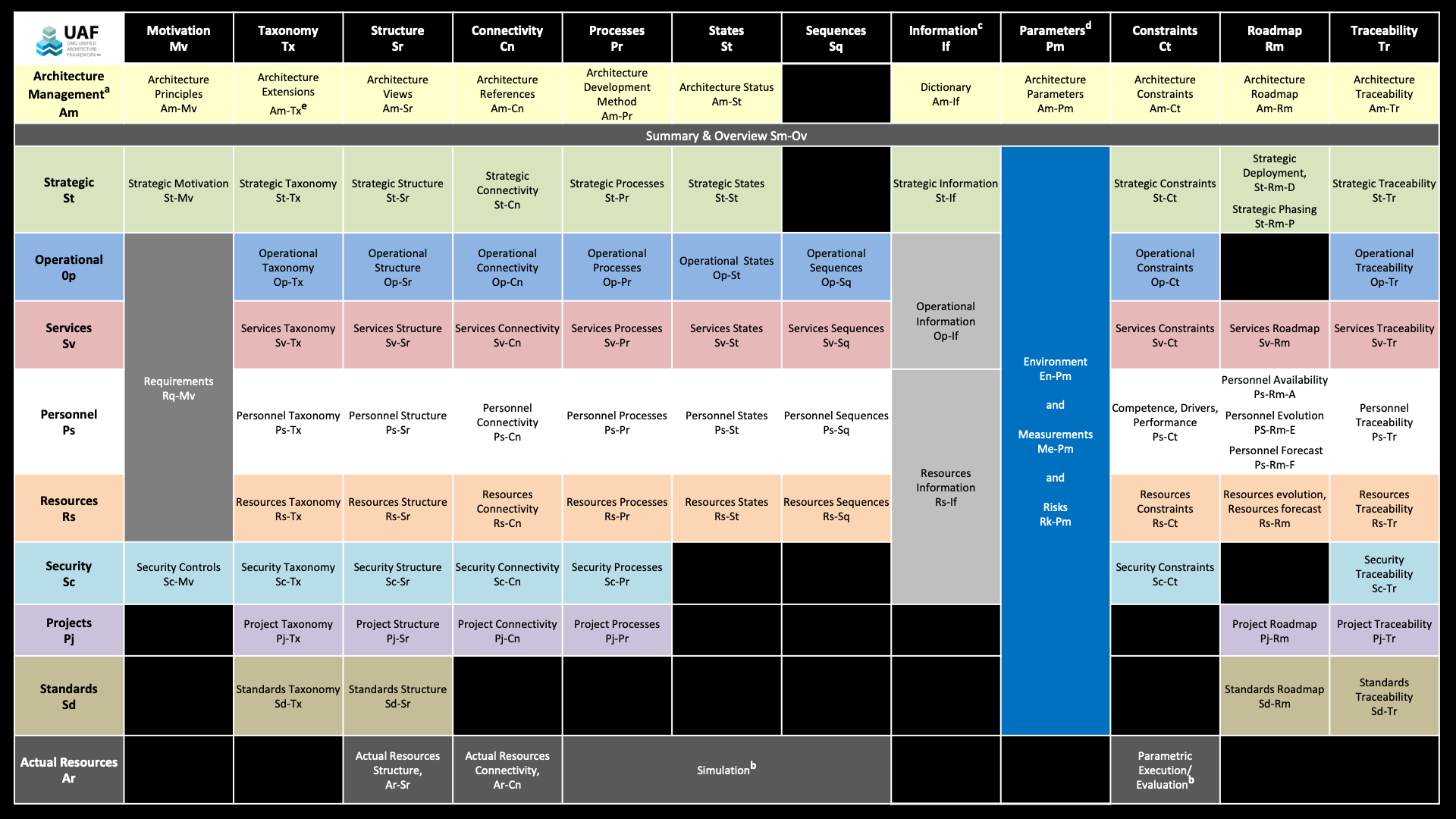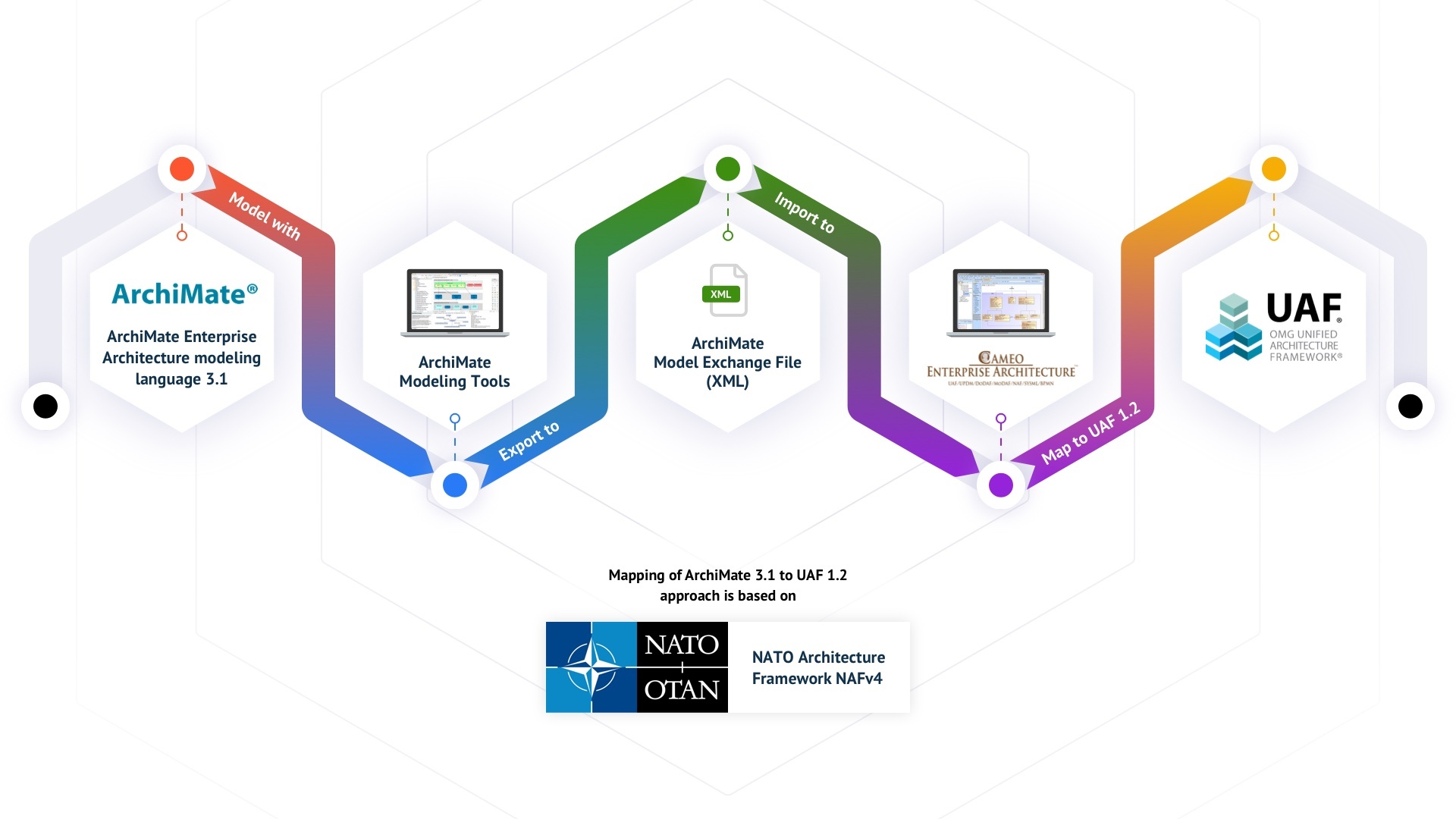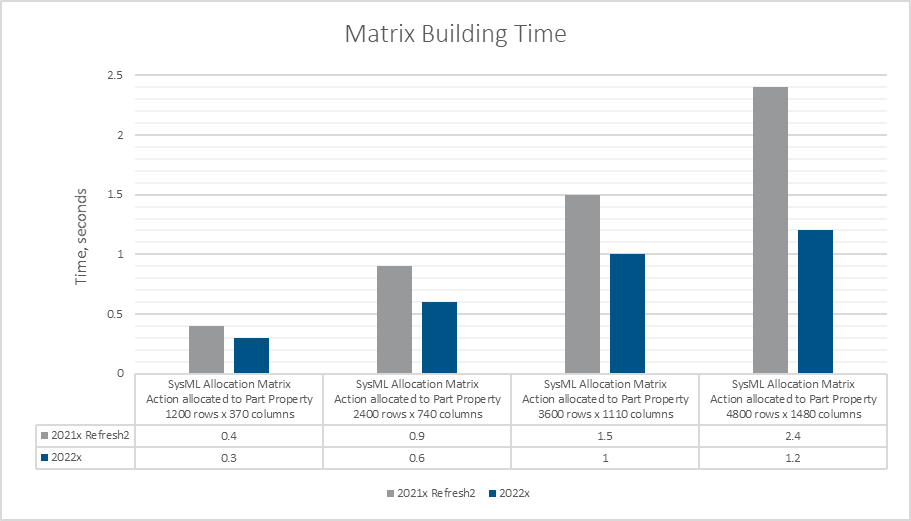Released: July 1, 2022
To download the latest version, see Downloading installation files. Don't forget to give us your feedback on LinkedIn, Twitter, or Facebook. For further information, check the product documentation.
UAF 1.2 Features
Methods and Standards
Beginning with this version, the UAF 1.2 Plugin is available for use in production. The UAF 1.2 Profile is fully supported in UAF, UAF Enterprise Architect, DoDAF, DoDAF 2.0, MODAF, NAF, and NAF 4.0 frameworks. The following migration will be necessary:
- UPDM 2.1 to UAF 1.2. Learn more about the changes >>
- UAF 1.0 to UAF 1.2. Learn more about the changes >>
- UAF 1.1 to UAF 1.2. Learn more about the changes >>
Learn more about the duration of project migration >>
IMPORTANT! The UAF 1.1 Plugin is no longer available.
Evolution of standards
UAF 1.2 support
Together with the UAF 1.2 Profile, the following changes (such as new aspects*, viewpoints**, diagrams, and tables) are implemented:
- Interaction Scenarios Aspect is renamed to Sequences Aspect.
- New Architecture Management Viewpoint:
- New Architecture Management diagram.
- Dictionary is a part of Architecture Management Viewpoint.
- New Motivation Aspect:
- New Strategic Motivation diagram.
- Requirements view specification is a part of Motivation Aspect for operational, personnel, resources viewpoints.
- New Security Controls diagram.
- Improvements in Strategic Viewpoint:
- Support of Value Streams.
- Introduced Strategic Constraints, new Strategic Constraint table in UAF Framework, and new C8 Planning Assumption table in NAF 4.0 Framework.
- Introduced Strategic Exchanges.
- New Strategic Processes diagram.
- Improvements in Services Viewpoint:
- Introduced Service Contract constraints.
- Introduced Service Exchanges.
- Service Association stereotype is introduced and applied to associations between Services.
- Resource Service introduced to model technical services, such as web services.
- Improvements in Security Viewpoint:
- Risks as a cross-cutting construct bringing new Risks diagram available in most viewpoints, under Parameters Aspect.
- New Security Constraints table.
- Implementation Matrix enhanced and adapted to UAF 1.2 Profile.
- Support Personnel Traceability.
- Functions to Operational Activities and Actual Responsible Resources to Actual Project Mapping matrices are available in Personnel Traceability View Specification.
- Improvements in Information Aspect:
- Dictionary is a part of Information Aspect.
- Introduced Strategic Information element and new Strategic Information diagram.
*Aspects were previously known as model kinds.
**Viewpoints were previously known as domains.
UAF 1.2 grid.
(Click the image to enlarge)
Library Support
New DISR and UJTL library versions are now available:
- UJTL (20220215)
- DISR (20211110)
You can choose the library version when creating a new project. Learn more about using libraries >>
ArchiMate Import (Technology preview)
In this version, we continued developing the import of the ArchiMate model from the open exchange file into the UAF project. The imported element mapping is still only partial, but adapted to the UAF 1.2 profile. The mapping of ArchiMate 3.1 to UAF 1.2 approach is based on the NATO Architecture Framework. Learn more >>
SysML Features
Instantiation Wizard Improvements
SysML Plugin 2022x brings several improvements in automatic instance creation using the Instantiation Wizard. You can now save time by specifying the names and custom stereotypes of Instance Specifications while creating them. We have also introduced new UI options that will help you select the elements to be instantiated quicker than before. Last but not least, the Instantiation Wizard performance has been improved for even better user experience.
Instantiation Wizard improvements.
SysML 1.7 Support
As of version 2022x, the SysML Plugin supports the upcoming SysML 1.7 specification which brings the following changes:
The QUDV model library for owned operations has been updated. The dependsOnUnits owned operation has been redefined with the dependsOnUnits operation owned by Unit for the following blocks: SimpleUnit, DerivedUnit, and ConversionBasedUnit. The dependsOnQuantityKinds owned operation for the SimpleQuanitityKind block has been redefined with the dependsOnQuantityKinds operation owned by QuantityKind.
- In the QUDV model library, the multiplicity of Prefix::Symbol has been changed from [1] to [0..1].
- A new symbol property allows renaming allocation compartments according to the SysML 1.7 standard. The "allocatedTo" compartment will be renamed to "allocatedToElements", and the "allocatedFrom" compartment to"allocatedElements".
Easier Requirement Verification
Performing automated Requirements verification in Requirement Tables is now easier as verification-specific columns and Legend are auto-displayed once the verification context - block or instance - is assigned.
Performance Improvements
Client-side Performance Improvements
Dependency Matrices. Experience enhanced in matrix building performance. From now on, large matrices are built up to 20 times faster compared to 2021x Refresh1.
A chart comparing the SysML Allocation Matrix building time in 2021x Refresh1 and 2021x Refresh2 projects.
Find. Now you can perform a search by phrase in the model 40-70 times faster compared to 2021x Refresh1. This is applicable to Find and Find and Replace dialogs as well as the Find operation used in Structured Expressions (e.g., Derived Properties, Smart Packages, Tables, Matrices, etc.)
A chart comparing the search by phrase time in 2021x Refresh1 and 2021x Refresh2 projects.
- Element selection dialog. Further performance improvements have been introduced to element selection (i.e., the Select Element dialog and drop-down lists). The element search can now be performed instantly when using Filter By Package Imports for context-specific type selection.
Teamwork Cloud-related Performance Improvements
Performance Improvements Under Slow Network
Performance improvements have been implemented to optimize working with Teamwork Cloud projects containing a set of used projects in slow network environments (ping time >115 ms).
A chart comparing the Project Load, Project Commit, and Project Update operations speed in slow network environments.
Integrations
Effectivity Import for TRM Requirements
Requirements from the TRM application on the 3DEXPERIENCE platform can be imported/synchronized into the modeling tools using Cameo DataHub. With 2021x Refresh2, DataHub can also import the effectivity markings of the requirements as equivalent variation points in the modeling tools.
The MagicDraw PLE mechanisms (variant highlight, variant realization transformation) can then be applied to these variable requirements.
As a prerequisite for effectivity import, Model Version variability and configurations have to be imported beforehand. Learn more about importing variability data >>
Note. The effectivity import is unidirectional. You can import from the 3DEXPERIENCE platform to the modeling tools.
Modeling and Infrastructure
Structured Expressions Improvements
Long-awaited improvements have landed! Working with Structured Expressions is now more convenient and less confusing.
- The Comparison operations, such as Equals, GreaterThan, and LessThan, can consume a set containing a single element, for instance, as returned by Metachain Navigation and Simple Navigation operations
- In cases you cannot find the needed property for the Property Test operation, you can now show the full list of properties instead of limiting it to properties applicable to the contextual element type only.
- Now all template operations (Simple Navigation, Metachain Navigation, Find, and Implied Relation) are represented in italic to clearly indicate that they are not specified. As a result, constant double-checks and manual removals of empty operations are no longer needed.
You can now apply changes to the Parameter name without the fear of breaking its usages within the Structured Expression specified in the Opaque Behavior body.
Stay tuned, more enhancements are coming in future versions!
Learn more about Structured Expressions>>
Other Improvements
From now on, suspect links in used projects are ignored when performing the suspect links analysis, meaning that the scope of the analysis is narrowed down to only relevant elements.
The Notification Window is no longer opened automatically when opening projects and switching between or creating new projects since the Notification Window status (open/closed) is now respected for each project individually.
Collaboration
Cloning Used Projects
Project cloning has been upgraded! For more effective working with Teamwork Cloud projects, you can now clone used projects together with the main project automatically by simply selecting a checkbox.
Cloning used projects together with the main project.
Other Teamwork Cloud-related Improvements
- For security reasons, you can now add an argument to the properties file of the modeling tool to hide logging in to Teamwork Cloud with the username/password.
- From now on, you can access the properties of the selected version much quicker since the Version Properties button has been added to the toolbar and the shortcut menu of the Content History and element History panels.
The Package permissions dialogs have been improved for usability purposes.
Report Wizard
- In this version, Report Wizard comes with an additional capability of getting derived property value by using $report.getStereotypeProperty() and $report.getStereotypePropertyString().
- With $report.isTypeOf(element, stereotypeName) for checking a supertype of the specific element, you are now able to check whether an element is a subtype of the specified stereotype. Get familiarized with this report tool >>
- The new Includes other files option in the Export dialog allows you to include related files of an exported template into the same MRZIP file. Learn more about the Template Management pane >>
- You can now customize page orientation and margin in double or String values with $pageprop.setPortrait($top, $bottom, $left, $right) and $pageprop.setLanscape($top, $bottom, $left, $right) functions. You can also set page orientation to portrait or landscape with $pageprop.setPortrait() and $pageprop.setLandscape() functions for generated reports. Learn how to customize the margin and set page orientation >>
- The current Velocity Template Language has been upgraded from Version 1.6.2 to 2.2. Find out more about the velocity templating language >>







